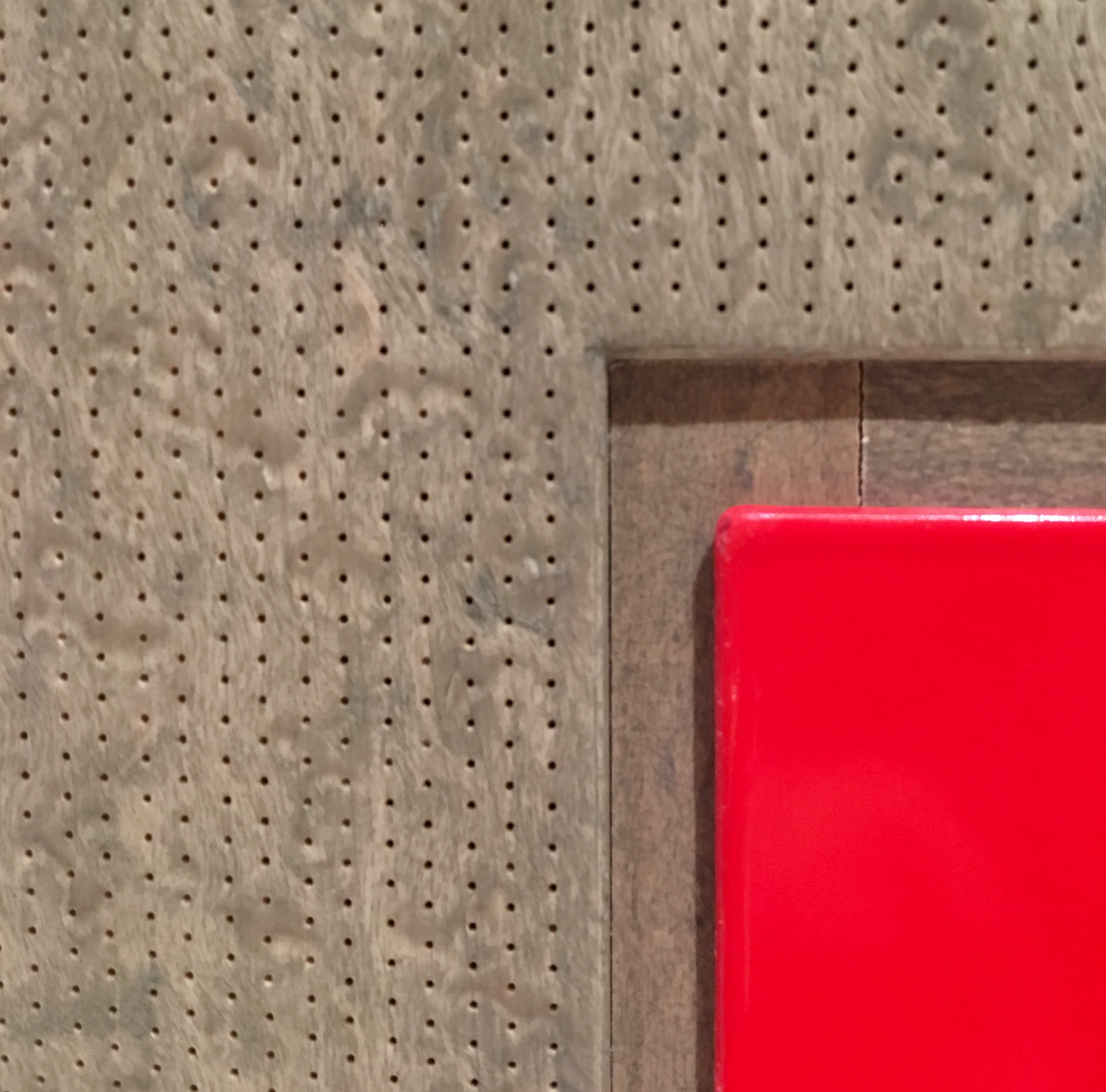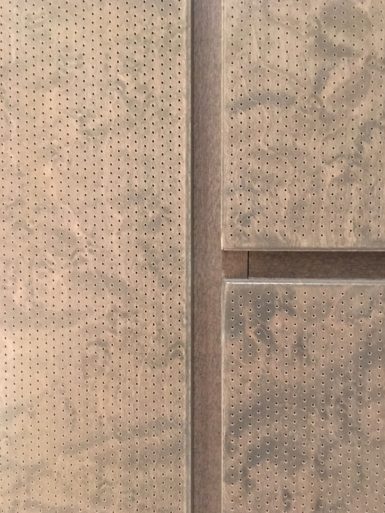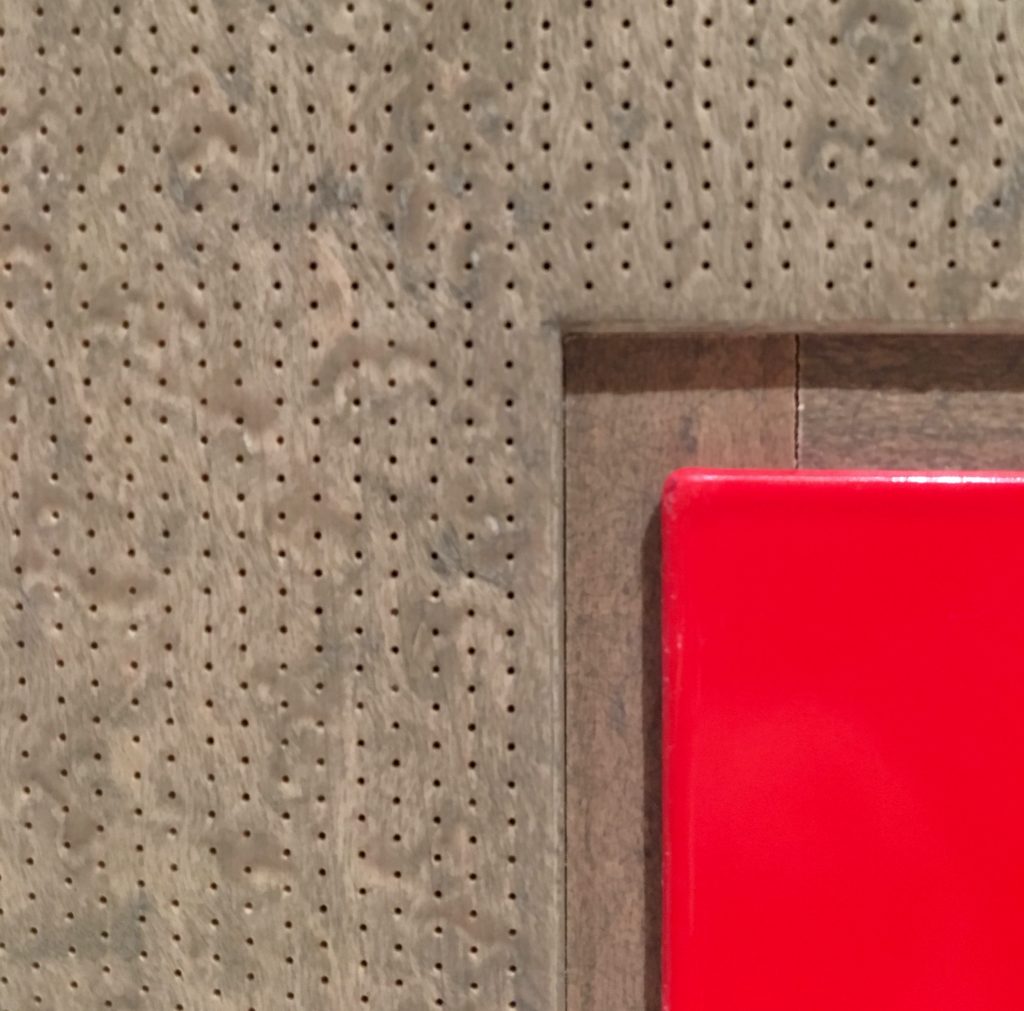[ad_1]

Closeup of a wall with perforations (plus a bit of a fire sign) in MoMA’s new central stairwell.
ANDY BATTAGLIA/ARTNEWS
Amid the din that can make a visit to the Museum of Modern Art in New York more than a little maddening is a new sanctuary for museum-goers in need of solace. It’s not any particular artwork to go and find (though there are, of course, many good candidates for that) but an unlikely setting that might be all too easy to take for granted: the stairwell that connects the old and new parts of the museum with a sleek design and, more important, a palpable sense of serenity that accompanies a surreal dampening of sound.
The quietude owes in part to Cerami & Associates, a New York–based acoustical engineering firm that worked on different aspects of the museum’s renovation. Its proposal for instilling something like silence was remarkably simple: many, many almost microscopic perforations poked into the wood that makes up the walls. At a distance, there’s nothing that the eye can see. But peer up close and you’ll be staring into what are effectively thousands of tiny tunnels into a restful, restorative abyss in which clamor turns to tranquility and chaos turns to calm.

More holes, more wall.
ANDY BATTAGLIA/ARTNEWS
“Acoustically, our job is to be invisible so that the experience is wholly of the artwork,” said Victoria Cerami, the CEO of a firm started by her father Vito more than 50 years ago. “We as acousticians are supporting whatever the architects’ message is and giving artists the ability to say what they want to say.”
What wants to be said in a stairwell is generally as little as possible, and a walk up and down the museum’s new so-called “blade stair” can be part of a smart strategy for those staying for a while. It’s in the middle of the building, so it can provide respite between galleries that are notably louder on either side. And the part that pauses on the third floor even has seating—a few couches, a nice leather chair—that can help a wilting visitor revive.
The micro-perforations, as Cerami & Associates’ project manager Matthew Schaeffler called them, came about in response to a desire for quiet in relation to two questions: “How do we accomplish it in an elegant way that lends itself to the space? And how do we make it not stand out as awful acoustic foam panels glued to the walls?”
More complicated was work that the firm did on MoMA’s new Studio space for live events and presentations of different kinds (currently an installation of sound-making contraptions and related performances titled “David Tudor and Composers Inside Electronics Inc.: Rainforest V (variation 1).” As Schaeffler explained, “The Studio had to be adaptable for many different uses, some of which would require very acoustically quiet environments, and the façade was something that came into play.”

The space separating layers of glass in the Studio, with a taxi blaring by below.
ANDY BATTAGLIA/ARTNEWS
One side of the Studio stares directly down on West 53rd Street—with all its attendant traffic plus whatever kinds of shenanigans transpire on a city street—so special considerations figured into the spacing between layers of glass in the room as well as the building’s exterior. “The Studio is actually a room within a room, with the inner room fully isolated from the outside on all six faces,” Schaeffler said, referring to the four walls plus the ceiling and the floor. Cerami added, “Think of it as an island: the room floats within the building.”
As opposed to typical building construction that might have a half-inch of space between layers of insulated glass, Cerami said, the Studio has about a foot-and-a-half of air in which sound can diffuse. And then there are other elements in the interior, such as walls that can tilt, for different desired sound effects, and acoustic drapery made of a high-density wool weave that soaks up sound. (“Wool is recommended by acousticians as an effective sound absorber across a wide range of frequencies,” reads a bit of promotional text on the website of Acoustacorp, the product’s manufacturer.)
The crowning jewel of the Studio may well be the “large custom pivot doors that have different acoustic elements to them that have never been done before,” Schaeffler said. A pneumatic seal surrounds the doors and can be inflated once they’re shut so as to keep sound in or out—“like a suction cup,” Cerami said. Depending on the occasion, the doors can provide a great deal of flexibility.
For all the hi-tech innovation, though, the holes in the walls in the central stairwell (as well as in the ceiling over the museum’s ground-floor ticketing area, which is approximately 20 million times quieter than it was before) exude a certain grace. As with many elements of acoustic design, Cerami said, the idea prioritizes the ear over the eye. “The reason why it works,” Cerami said, “is because you can’t see it.”
[ad_2]
Source link

